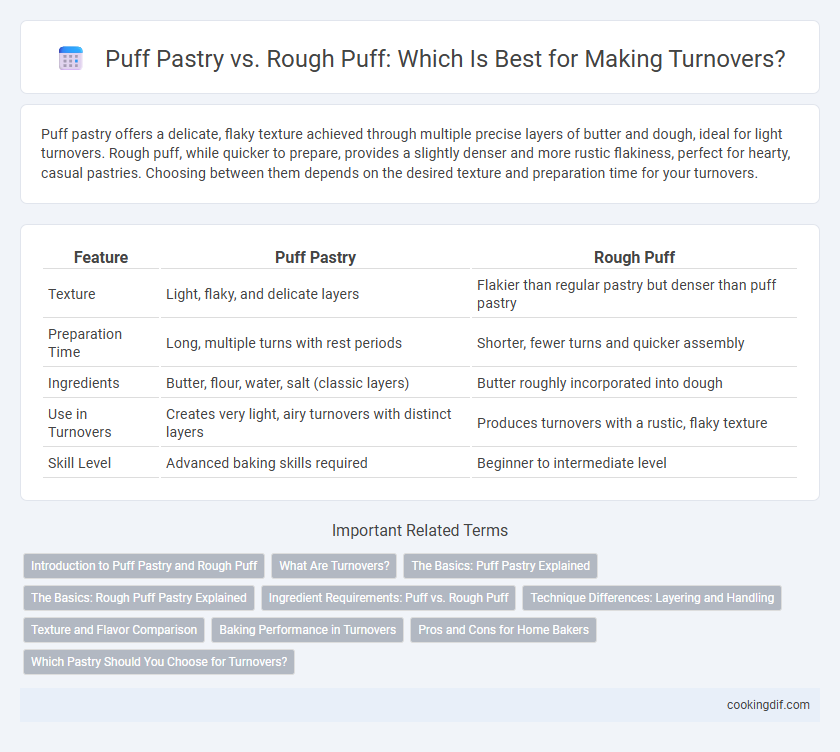Puff pastry offers a delicate, flaky texture achieved through multiple precise layers of butter and dough, ideal for light turnovers. Rough puff, while quicker to prepare, provides a slightly denser and more rustic flakiness, perfect for hearty, casual pastries. Choosing between them depends on the desired texture and preparation time for your turnovers.
Table of Comparison
| Feature | Puff Pastry | Rough Puff |
|---|---|---|
| Texture | Light, flaky, and delicate layers | Flakier than regular pastry but denser than puff pastry |
| Preparation Time | Long, multiple turns with rest periods | Shorter, fewer turns and quicker assembly |
| Ingredients | Butter, flour, water, salt (classic layers) | Butter roughly incorporated into dough |
| Use in Turnovers | Creates very light, airy turnovers with distinct layers | Produces turnovers with a rustic, flaky texture |
| Skill Level | Advanced baking skills required | Beginner to intermediate level |
Introduction to Puff Pastry and Rough Puff
Puff pastry is a classic laminated dough made by repeatedly folding butter into the dough, creating distinct, flaky layers perfect for delicate turnovers. Rough puff offers a quicker alternative, combining chunks of butter directly into the dough before folding, producing a slightly less flaky but still tender texture. Both methods yield buttery pastries, with traditional puff pastry delivering a lighter, more refined flakiness compared to the rustic, denser layers of rough puff.
What Are Turnovers?
Turnovers are flaky, folded pastries filled with sweet or savory ingredients, often baked or fried to golden perfection. Puff pastry creates ultra-light, delicate layers due to its numerous butter and dough folds, resulting in a crisp exterior ideal for fruit or cream cheese turnovers. Rough puff offers a quicker alternative with fewer layers, producing a slightly denser texture perfect for hearty fillings like meat or vegetables in savory turnovers.
The Basics: Puff Pastry Explained
Puff pastry is a delicate, laminated dough made by folding butter between multiple layers of dough, creating a flaky, airy texture ideal for turnovers that require a buttery crisp finish. Rough puff, also known as blitz pastry, is a quicker alternative where cold butter is roughly incorporated into the dough, offering a slightly denser texture but still achieving a layered effect. For turnovers, traditional puff pastry delivers superior flakiness and lift, whereas rough puff provides a convenient option with a tender crumb and faster preparation time.
The Basics: Rough Puff Pastry Explained
Rough puff pastry combines the flakiness of traditional puff pastry with a quicker preparation method, ideal for turnovers requiring a delicate, buttery texture. It involves folding cold butter chunks into the dough less meticulously than classic puff pastry, producing visible layers without extensive lamination. This technique balances ease and crispness, making rough puff pastry a practical choice for flaky, tender turnovers.
Ingredient Requirements: Puff vs. Rough Puff
Puff pastry requires precise layering of cold butter and dough through multiple folds to achieve a delicate, flaky texture, while rough puff uses larger chunks of butter blended into the flour for a quicker, less meticulous process. Puff pastry typically needs higher-quality butter and precise temperature control to maintain the distinct layers, whereas rough puff is more forgiving with ingredient proportions and timing. Both rely on cold butter and flour, but puff pastry demands more ingredient refinement for superior lightness and rise in turnovers.
Technique Differences: Layering and Handling
Puff pastry involves meticulously folding and rolling multiple thin layers of dough and butter to create a delicate, flaky texture, while rough puff uses a faster method of incorporating chunks of butter into the dough with fewer folds for a more rustic, less refined crumb. The precise layering in traditional puff pastry requires careful handling to maintain distinct layers, whereas rough puff is more forgiving with less emphasis on uniformity and delicate rolling. For turnovers, puff pastry yields a lighter, airier crust, and rough puff provides a heartier, slightly denser bite with a similarly crisp finish.
Texture and Flavor Comparison
Puff pastry offers a delicate, flaky texture with distinct, crisp layers that elevate turnovers with buttery richness and a light, airy bite. Rough puff features a slightly denser, more rustic crumb, delivering a heartier chew and a less uniform rise while retaining a buttery flavor that enhances savory fillings. Choosing between them depends on whether a refined flakiness or a robust, textured bite is preferred for the turnover experience.
Baking Performance in Turnovers
Puff pastry delivers a consistently flaky and delicate texture in turnovers due to its precise lamination and multiple butter layers, which create significant steam during baking. Rough puff, while easier and faster to prepare, produces a slightly denser and less uniform rise because it incorporates butter in larger chunks, resulting in fewer and thicker layers. Both doughs achieve a golden crust, but puff pastry offers superior lift and crispness essential for light, airy turnovers.
Pros and Cons for Home Bakers
Puff pastry offers delicate, flaky layers ideal for elegant turnovers but requires time-consuming folding and chilling processes that may challenge home bakers. Rough puff pastry provides a quicker, more forgiving alternative with a slightly coarser texture, which suits beginners or those needing faster preparation. Home bakers prioritize rough puff for ease and speed, while puff pastry is favored for superior puff and refined texture despite its complexity.
Which Pastry Should You Choose for Turnovers?
Puff pastry provides a delicate, flaky texture ideal for light, buttery turnovers, while rough puff offers a quicker preparation with a slightly denser, more rustic flakiness. For turnovers requiring a tender crumb and impressive lift, traditional puff pastry is preferred; rough puff suits recipes where speed and a heartier bite are more important. Consider the desired texture and preparation time to determine the best pastry choice for your turnovers.
Puff pastry vs rough puff for turnovers Infographic

 cookingdif.com
cookingdif.com